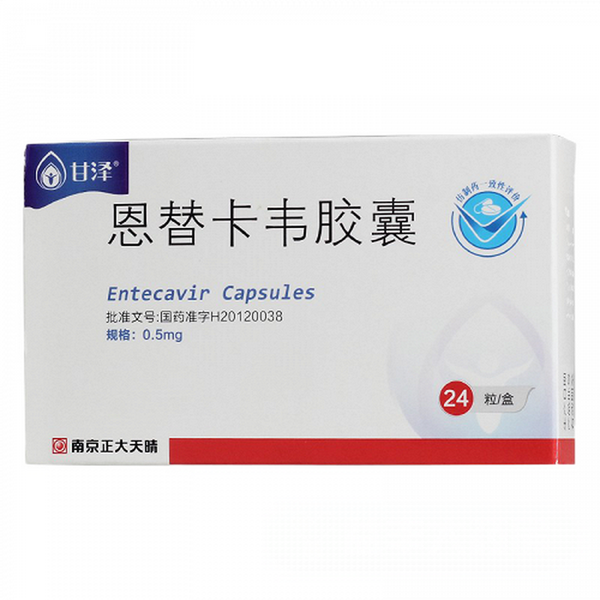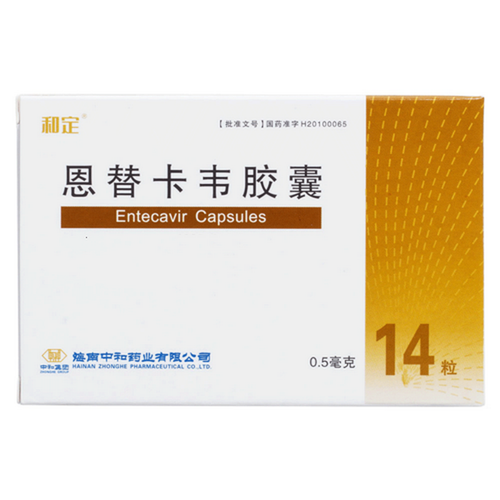Product Overview
[Drug Name]
Generic Name: Entecavir Capsules
Trade Name: Ganze
English Name: Entecavir Capsules
[Ingredients]
The main ingredient of this product is entecavir.
[Appearance]
This product is a capsule containing white or off-white pellets.
[Indications]
For the treatment of chronic hepatitis B in adults with active viral replication, persistently elevated serum ALT, or active liver histological lesions.
[Dosage and Administration]
Patients should take Entecavir under the guidance of an experienced physician. Recommended Dose: Adults and adolescents aged 16 years and above should take 0.5 mg of Entecavir orally once daily. Patients who develop viremia or lamivudine-resistant mutations during lamivudine treatment should take 1 mg orally once daily. Entecavir should be taken on an empty stomach (at least 2 hours before or after a meal). Renal Insufficiency: In patients with renal insufficiency, the apparent oral clearance of Entecavir decreases with decreasing creatinine clearance. Patients with creatinine clearance <50 ml/min (including those receiving hemodialysis or continuous ambulatory peritoneal dialysis (CAPD)) should have their dose adjusted. Hepatic Impairment: No dose adjustment is required for patients with hepatic impairment. Treatment Duration: The optimal duration of entecavir treatment and its relationship to long-term treatment outcomes, such as cirrhosis and liver cancer, are currently unknown.
[Adverse Reactions]
Adverse reactions were evaluated based on four global clinical trials: AI463014, AI463022, AI463026, and AI463027, as well as three clinical trials conducted in China (AI463012, AI463023, and AI463056). A total of 2,596 patients with chronic hepatitis B were enrolled in these seven studies. In studies compared with lamivudine, entecavir and lamivudine had similar adverse events and laboratory abnormalities. In international studies, the most common adverse events with this product were headache, fatigue, dizziness, and nausea. Common adverse events in patients treated with lamivudine include headache, fatigue, and dizziness. Across the four studies, 1% of patients treated with entecavir and 4% of patients treated with lamivudine discontinued the studies due to adverse events and laboratory abnormalities.
[Contraindications]
Entecavir is contraindicated in patients with allergies to entecavir or any of its ingredients.
[Precautions]
Exacerbations of hepatitis after discontinuation of treatment: Severe acute hepatitis flares have been reported in patients with chronic hepatitis B who discontinue anti-hepatitis B therapy, including entecavir. Liver function should be closely monitored clinically and with laboratory tests, and follow-up should be continued for at least several months. If necessary, anti-hepatitis B virus therapy can be resumed.
[Use in Special Populations]
Precautions for use in children under 16 years of age:
Safety and efficacy data for this drug have not been established.
Precautions for Pregnancy and Lactation:
The effects of entecavir on pregnant women have not been adequately studied. This drug should only be used after a thorough balance of potential risks and benefits for the fetus. Currently, there are no data suggesting that this drug affects mother-to-child transmission of HBV. Therefore, appropriate interventions should be implemented to prevent neonatal HBV infection. Entecavir is excreted in rat milk. However, whether it is excreted in human milk remains unclear, so breastfeeding is not recommended for mothers taking this drug. (See package insert for details.)
Precautions for Elderly Patients:
Due to the lack of adequate clinical studies with patients aged 65 years and older, it is unclear whether elderly patients respond differently to this drug compared to younger patients. Other clinical trial reports have not found differences between elderly and younger patients. Entecavir is primarily excreted by the kidneys, and the risk of toxic reactions may be higher in patients with renal impairment. Because elderly patients often have decreased renal function, careful consideration should be given to drug dosage selection and renal function monitoring should be performed. (See package insert for details.)
[Drug Interactions]
The metabolism of entecavir has been evaluated in vitro and in vivo. Entecavir is not a substrate, inhibitor, or inducer of the cytochrome P450 (CYP450) enzyme system. At concentrations approximately 10,000 times the human concentration, entecavir does not inhibit any of the major human CYP450 enzymes: 1A2, 2C9, 2C19, 2D6, 3A4, 2B6, and 2E1. At concentrations approximately 340 times the human concentration, entecavir does not induce any of the major human CYP450 enzymes: 1A2, 2C9, 2C19, 3A4, 3A5, and 2B6. Concomitant administration of drugs that inhibit or induce the CYP450 system has no effect on the pharmacokinetics of entecavir. Furthermore, concomitant administration of entecavir has no effect on the pharmacokinetics of known CYP substrates. Interaction studies of entecavir with lamivudine, adefovir, and tenofovir revealed no alterations in the steady-state pharmacokinetics of either entecavir or the interacting drugs. Because entecavir is primarily eliminated by the kidneys, coadministration of entecavir with drugs that reduce renal function or compete for active glomerular secretion may increase the plasma concentrations of these drugs. Concomitant use of entecavir with lamivudine, adefovir, and tenofovir does not cause significant drug interactions. The interaction between concomitant use of entecavir and other drugs that are cleared by the kidneys or known to affect renal function has not been studied. Patients taking entecavir concurrently with these drugs should be closely monitored for adverse reactions.
[Pharmacological Action]
Pharmacological Action Microbiological Mechanism of Action This product is a guanine nucleoside analog that has an inhibitory effect on hepatitis B virus (HBV) polymerase. It can be converted into an active triphosphate through phosphorylation, and the half-life of the triphosphate in the cell is 15 hours. By competing with the natural substrate of HBV polymerase, deoxyguanosine triphosphate, entecavir triphosphate can inhibit all three activities of viral polymerase (reverse transcriptase): (1) initiation of HBV polymerase; (2) formation of the negative strand of pregenomic mRNA reverse transcription; (3) synthesis of the positive strand of HBV DNA. The inhibition constant (Ki) of entecavir triphosphate on HBV DNA polymerase is 0.0012M. Entecavir triphosphate has a weak inhibitory effect on cellular α, β, δ DNA polymerase and mitochondrial γ DNA polymerase, with Ki values ranging from 18 to greater than 160uM. Antiviral activity: In human HepG2 cells transfected with wild-type hepatitis B virus, the concentration required for 50% inhibition of viral DNA synthesis (EC50) of entecavir was 0.004 μM. The median EC50 for entecavir against lamivudine-resistant viral strains (rtL180M, rtM204V) was 0.026 μM (range, 0.01-0.059 μM). Coadministration of entecavir with HIV nucleoside reverse transcriptase inhibitors (NRTIs) is unlikely to reduce the anti-HBV efficacy of entecavir or any of the other agents in this class. In testing HBV combination therapy in cell culture, abacavir, didanosine, lamivudine, stavudine, tenofovir, or zidovudine did not antagonize the anti-HBV activity of entecavir over a wide range of concentrations. In HIV antiviral activity studies, entecavir showed no antagonistic effect on the anti-HIV activity of six NRTIs in cell culture at concentrations four times greater than the peak in vivo concentration. A comprehensive analysis of entecavir's inhibitory activity against a panel of laboratory and clinical isolates of human immunodeficiency virus type 1 (HIV-1) revealed EC50 values ranging from 0.026 to 10 μM across various cell types and experimental conditions; lower EC50 values were observed when viral levels decreased. In cell culture, entecavir selectively targets the M184I substitution in HIV reverse transcriptase at micromolar concentrations, with inhibition confirmed at higher entecavir concentrations. HIV variants harboring the M184V substitution are insensitive to entecavir. Lamivudine-resistant HBV strains (LVDr) harboring substitutions at the rtM204I/V and rtL180M sites in the reverse transcriptase region exhibited an 8-fold decrease in susceptibility to entecavir compared to wild-type HBV strains in cell culture. Incorporation of additional entecavir-resistant amino acid substitutions at rtT184, rtS202, and/or rtM250 sites also reduced susceptibility to entecavir in cell culture. Clinical isolates harboring additional substitutions (rtT184A, C, F, G, I, L, M, or S; rtS202C, G, or I; and/or rtM250I, L, or V) further reduced susceptibility to entecavir by 16-741-fold compared to wild-type HBV strains. Entecavir resistance substitutions at rtT184, rtS202, and rtM250, isolated from the entecavir strains, have only a modest effect on entecavir susceptibility, and no reduced susceptibility has been observed in over 1,000 patients without lamivudine resistance substitutions. In cell culture, resistance has been shown to be mediated by alterations in HBV reverse transcriptase that reduce competitive binding, resulting in reduced replication of resistant HBV strains. In clinical studies, patients initially treated with entecavir 0.5 mg (nucleoside-naive) or 1 mg (lamivudine-failure) who had on-treatment HBV DNA PCR values at or after week 24 of treatment were monitored for resistance. In nucleoside-naive patients, genetic testing evidence of entecavir resistance substitutions at rtT184, rtS202, and/or rtM250 was found in 1% of patients treated with entecavir for up to 144 weeks (see table below). Substitutions at these sites were found to confer entecavir resistance only on the basis of the emergence of lamivudine-resistant sites (rtM204V and rtL180M). The number of patients who developed genotypic entecavir resistance and were tested for resistance during the 144-week study in nucleoside-naive patients (including patients with on-treatment PCR-detected HBV DNA values at or after Week 24 of the 58-week study (1 year), between Weeks 58 and 102 of the study (2 years), or between Weeks 102 and 156 of the study) was: 663 at Year 1, 278 at Year 2, and 149 at Year 3a. Number of patients with genotypic resistance to entecavir (patients also had lamivudine-resistance site substitutions): 1 patient (1%) at 1 year, 1 patient (1%) at 2 years, and 1 patient (1%) at 3 yearsa. Cumulative incidence of genotypic resistance to entecavir (patients also had lamivudine-resistance site substitutions): 0.2% at 1 year, 0.5% at 2 years, and 1.2% at 3 yearsa. Number of patients with virologic rebound (≥1 log10 increase in HBV DNA from nadir by PCR, confirmed by serial testing or at the end of the time window) due to entecavir resistance (in patients with concurrent lamivudine resistance site substitutions): 1 patient (1%) at 1 year, 0 patients at 2 years, and 1 patient (1%) at 3 yearsa. The 3-year results reflect 147 of 149 patients who received entecavir 1.0 mg in the entecavir continuation study, and 130 patients who received entecavir and lamivudine combination therapy for a median of 20 weeks (followed by long-term entecavir therapy). Patients with lamivudine failure: 10 of 187 baseline viral isolates (5%) from patients who failed entecavir therapy and underwent resistance surveillance were found to have entecavir resistance site substitutions, suggesting that prior lamivudine therapy selected for these resistance sites and that they were present at low levels before entecavir treatment. Throughout the 144-week study, 3 of the 10 patients experienced virological rebound (an increase of ≥1 log10 from the nadir). (See package insert for details.)
[Storage] Store in a dark, airtight container in a dry place below 25°C.
[Strength] 0.5 mg
[Packaging] 0.5 mg x 24 tablets
[Expiry Date] 24 capsules
[Approval Number] National Medicine Standard H20120038
[Manufacturer] Company Name: Nanjing Zhengda Tianqing Pharmaceutical Co., Ltd.








